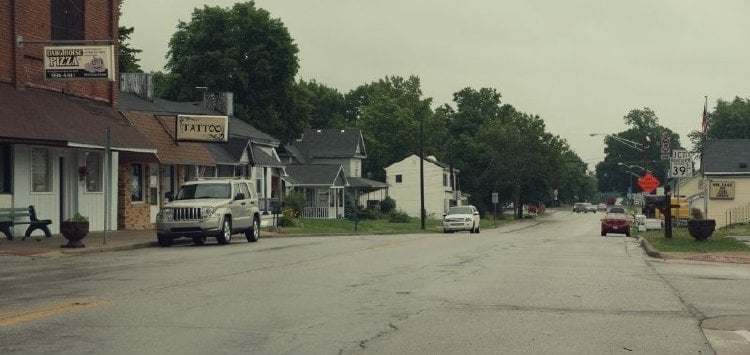Monrovia, Indiana

Frederick Wiseman has produced and directed documentary films since his debut in 1967 with “Titicut Follies (1967)” and has, since, created scores of in-depth looks at our cities, towns, institution and neighborhoods, here and abroad. Now, he takes us to the heartland of America, “Monrovia, Indiana.”
Laura's Review: B+
It's been almost twenty years since America's greatest documentarian, 88 year-old Frederick Wiseman, has looked at small town life, having spent the years since 1999's "Belfast, Maine" in London, Paris, Los Angeles, Boise, Austin and New York City. Now, in a deeply divided country, Wiseman trains his singular focus on the staunchly Republican, 96.3% white "Monrovia, Indiana." Even without city streets, urban bustle and institutional building hallways, we immediately know whose hands we are in, Wiseman opening his film with a series of establishing shots before landing on Monrovia's city sign. There are flat, wide expanses, lots of farms, a big open sky, cows and pigs on raised wooden platforms and a two-story high town center only a few blocks long. And yet this is the first Wiseman documentary I've seen that's sent me off to research things like demographics, trying to distinguish what the filmmaker is getting at here. It seems like this might be that great America Republicans are so hell bent on preserving. Ironically, there are few moments in the almost two and a half hour film where anyone looks like they are having a good time. As Wiseman's camera cruises a high school's hallways, we learn it's been around for quite some time, high school class photos dating back to 1921, framed non pictorial documents going back to 1884. At a Masonic Lodge meeting, a member is recognized for fifty years of service. The town appears to support one restaurant, one barber, a hair salon, a pizza place and the type of grocery store that still blasts its specials to customers over a loudspeaker. One wonders how the tattoo parlor remains in business. There are quite a few churches, an active liquor store and a gun store where one guy talks bullets while a woman checks out the aim on a rifle. We drop in on a city planning board meeting a couple of times. Two of its members seem very concerned about Homestead, a housing development they fear is changing their demographics. The only resident of Homestead we see is an older white man from Indianapolis. Indianapolis voted for Obama in 2008 and their median income is double that of Monrovia - is this the concern? There are also infrastructure issues with the development, however, that resident come to complain about fire hydrants that cannot be used for firefighting. One member of the board appears to be quite open minded, pushing back about Homestead's drain on their police department, arguing that it gets no more calls than the rest of Monrovia. The rest of their discussion involves the planning of a new public bench. We drop in at a wedding well past the halfway mark and witness our first black person, the wedding's female singer. There is a baby shower in a community center. At the local cafe, a group of older guys trade local gossip. In Monrovia and its surrounding towns, a person of a certain last name clearly must be related to another of the same last name that they know. This is the type of community where everyone knows everyone, yet we wonder what its younger people do for entertainment, or if they tend to stay or leave the area. (Statistics show a low percentage of college graduates, leading one to surmise generations continue to farm the land.) Such a large number turns out for the Monrovia Festival, a senior guides traffic on the main drag. We see our second black person, a vendor. The festival seems mostly comprised of vendors selling goods, like pro-gun, anti-welfare decals, and food. There is also a children's tap performance, some musical performances and an antique car exhibit in a field. Wiseman wraps on a funeral eulogy and internment for a 74 year-old woman. People are born, get married and die in Monrovia and little seems to change except for agricultural technology and that new housing development. As always, a Wiseman documentary is a compelling, immersive experience, but unlike his more recent outings it doesn't feel like a celebration of its subject. It is the most ambiguous of his works that I have seen. Grade:
Robin's Review: B
No matter what the subject, Wiseman is famous for his “un-staged, un-manipulated” (Wiseman’s words) fly-on-the-wall point of view inspection. My favorite film by the maestro is “In Jackson Heights (2015),” an in-depth look at the cultural and social diversity of that neighborhood in Brooklyn. “Monrovia, Indiana,” though, is a study of the homogenous, predominantly white titular town, population 1061 (2010 US Census). We begin our journey to Monrovia at a cattle farm and a pig farm. We move on to the town and attend a sermon at the Monrovia Christian Church, school getting out, a visit to Hot Rod’s Barber Shop, a yard sale, the Dawg House of Pizza as they make their pies, the local cemetery, town council meetings, Wagner Collision Repair, a Masonic Lodge ceremony and spend time with the locals at the Café on the Corner. Of course, if you know Frederick Wiseman, there is much, much more to be seen in the life of the tiny town. Without using interviews or making the documentary maker a part of the film, Wiseman immerses us into town life and what goes on day to day. Nothing “exciting” happens as you watch this life go by, but the maestro has the magic of his art to keep you interested for 2.5 hours. I will leave the thoughts and analysis of what Wiseman shows us for you to decide what you think. I know I have my own thoughts.

